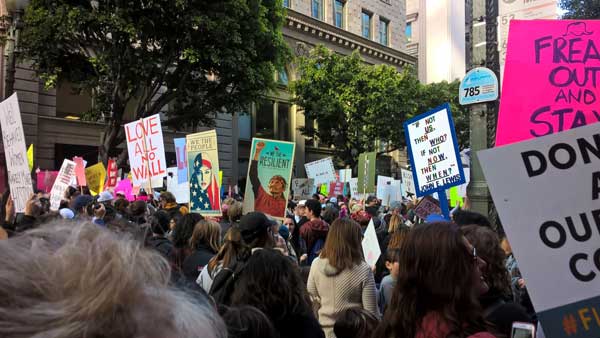Revolution in the Making
“It was the best of times, it was the worst of times, it was the age of wisdom, it was the age of foolishness, it was the epoch of belief, it was the epoch of incredulity …” Charles Dickens was writing about London and Paris before and during the French Revolution, but that line rings so true now as we enter the Era of He Who Cannot Be Named. The election found this country deeply polarized, and we now know that the Russians had a hand in influencing the vote, although of course the popular vote went for Hillary Clinton by 2.9 million votes. Dickens ostensibly wrote about two cities, but he was writing about the rich and the poor, the haves and the have-nots in a time of extremes.
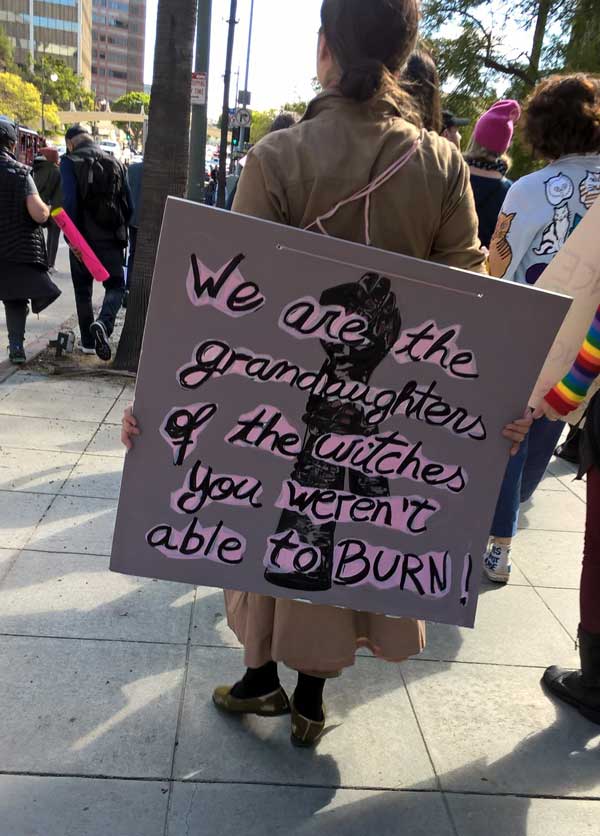
homemade sign at Women’s March, photo by Scarlet Cheng.
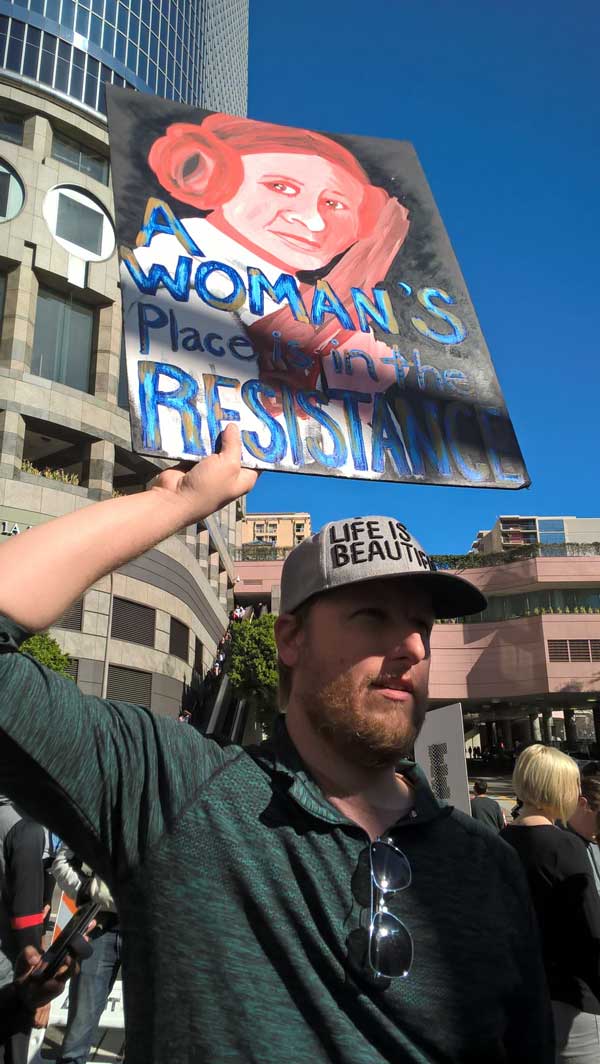
Homemade sign at Women’s March LA, photo by Scarlet Cheng.
The Women’s March in Los Angeles was extraordinary – the turnout four to five times what was predicted. The numbers have been counted as from half a million to 750,000 marchers, and Pershing Square could not contain them during the pre-march rally. And those gathered were peaceful, friendly, courteous. I heard one man say towards the end, “If this is matriarchy, I want to live in a matriarchy!” Art was used to convey the protest and resistance, signs and posters proliferated. There were recognizable pre-printed ones, thanks to Shepard Fairey, Jessica Sabogal, Ernesto Yerena, and the Amplifier Foundation, who provided posters and signs through a staggeringly successful Kickstarter campaign. But most signs were homemade, and they were striking. On one corner a man held up a painting of Princess Leia (Carrie Fisher, R.I.P), with the words “A Woman’s Place is in the Resistance.” To all those who came up to compliment him, he said, “My girlfriend painted this, and couldn’t come because she had to work today, so I’m here in her place.” (photo above)
On another activist front, Kim Schoenstadt expanded her “Now Be Here” project to other cities last fall. In August it began in Los Angeles with a group photo of 733 women artists in the courtyard of Hauser, Wirth & Schimmel (resulting in a photo by Isabel Avila & Carrie Yury). In October, 600 women artists showed up at the Brooklyn Museum in Brooklyn, New York, where Schoenstadt collaborated with Shinique Smith and photographer Paola Kudacki. In December, 300 women artists gathered at the Perez Art Museum in Miami for their chance before the camera, a project done with the Girls’ Club, artist Jane Hart and photographer Gesi Schilling. Good going, Kim!
The Artists’ Political Action Network (APAN) bravely launched its inaugural public meeting at 356 Mission Road on Sunday, February 13. “We seek to construct a network for artists,” says their Facebook statement, “to share information, coordinate responses with established organizations, and leverage our cultural capital to effect meaningful change in our communities, at the state level, and nationally.”
That day the action began outside as a handful of demonstrators protesting gentrification in Boyle Heights yelled “Don’t cross the picket line!” and “A gentrified space is not a safe space!” Inside over 200 people were packed in, throwing out concerns to Andrea Fraser and the other APAN organizers (Kathryn Andrews, Charles Gaines, Liz Glynn, Tala Madani, Monica Majoli, Laura Owens and Kulapat Yantrasast) sitting at the front of the room, beneath a screen projection showing an evolving list. These ranged the gamut of issues including immigration, women’s rights, electoral politics. Afterwards subcommittees to focus on those concerns broke out and met in the outside lot, eventually returning to the larger hall to announce their upcoming meeting plans and overall agenda. Yours Truly went to join the healthcare committee, but we were so few we decided to join the women’s rights group.
So stay tuned for what happens next… However, I don’t think the next meeting will be on Mission Road.
A New Direction for MOLAA
Cultural history was made down in Long Beach in February, with the opening of the exuberant “Dreamland: A Frank Romero Retrospective” (through May 21) at the Museum of Latin American Art. Over 200 works cover five decades of Romero’s career, from early days to his time with Los Four to now. The artist is famous for his series of highly charged, political paintings about police suppression of Chicanos in LA in the 1980s, including The Closing of Whittier Boulevard (1984) and Death of Rubén Salazar (1988)—both of which are featured in this wonderful show.
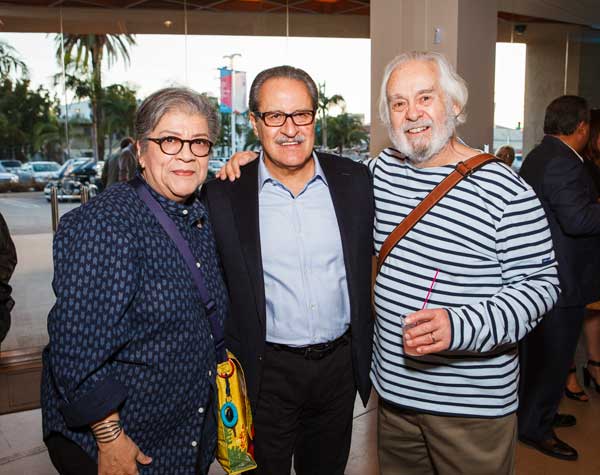
Càstulo de la Rocha, Frank Romero, Sharon Romero at opening of Dreamland.
“This is the first solo show for a Chicano artist at this museum,” said Edward Hayes, curator of exhibitions, at the opening. Sounds shocking, but the museum was set up by its founder Robert Gumbiner to feature only Latin American art, a rule that got tossed only recently. Long overdue, it seems to me.
Gallery Moves
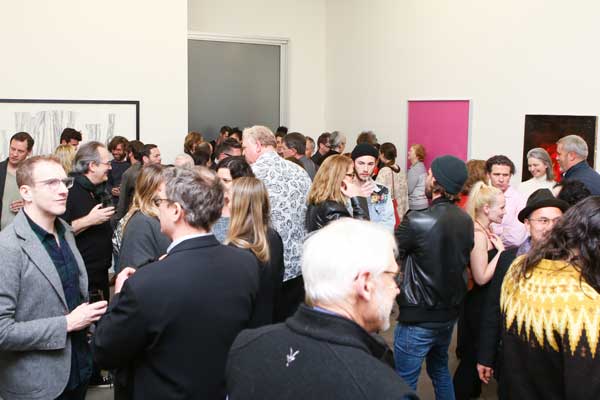
Opening at Praz-Delavallade.
On January 29, a new gallery opened on Wilshire Boulevard—Praz-Delavallade, the first Parisian gallery to set up in LA, they say. In the 1990s gallery partners René-Julien Praz and Bruno Delavallade showed a number of LA artists in Paris. Now they’ve opened here with a show appealing to this fair city, shamelessly titled “I Love LA,” including artists Sam Durant, Julian Hoeber, Jim Isermann, Amanda Ross-Ho, Analia Saban, Jim Shaw, and Marnie Weber.
Shulamit Nazarian has moved from beachy Venice to busy North La Brea. “I wanted to be closer to other galleries,” she said, “and this is a bigger space.” Her gallery was formerly the first floor of a townhouse right by the beach, just a few doors down from LA Louver, but it always felt like a tight fit, especially when larger drawings and paintings were shown. On Feb. 18, they launched their new space with a group show, “Escape Attempts” (through April 18).
The art world is a revolving door, and there are also some farewells we must note. Mark Moore closed his Culver City store after 33 years in the business, although he will maintain sales online and by appointment. “Young people don’t seem to have the interest or inclination to collect,” Moore told Artnet, “while those who have been driving the market seem to be winding down their collecting as they enter retirement age, along with concerns about the future during this election year.” He also mentioned the attraction of auctions for collectors wishing to sell art, another drain from the coffers of storefront galleries. Also in Culver City, Michael Maloney decided to shutter his gallery at the beginning of the year. From now on, he plans to focus on his appraisal business.
In another part of town, the Ruth Bachofner Gallery has become a casualty of the changes and uncertainty that have been plaguing the Bergamot Station arts complex. Last year the Metro came to the corner, bringing welcome mass trans (well, maybe not, from the galleries’ point of view) but necessitating the destruction of buildings that had been Track 16. No one seems to know what will happen next, with proposals for hotel and retail on the table, while the City of Santa Monica has been wishy-washy about guaranteeing the continued existence of the remaining art galleries.
Bachofner closes March 31, after 33 years in the business, 19 of them at the current location. “Over these many years we have featured close to 400 solo and 70 group shows, exhibiting emerging and well-known artists from California, New York and Euorpe, with a total of almost 300 artists,” they say in a press release. “At the end of 2016, our building in the complex sold, and as a result our costs have increased considerably.”
Drop by their closing party on March 11, 4–7 pm. Let’s just hope it’s not the beginning of Bergamot’s last gasp—LA is a big big city, so we absolutely need to have multiple art centers.
LA Art Fairs Report
January was packed with rain and art fairs—three returning veterans in their established venues, and the upstart stARTup Fair LA back for a second year in a new location. The behemoth LA Art Show (Jan. 11–15) at the downtown Convention Center shrank to a more manageable size again, after becoming far too sprawling. It seems to me that overall quality improved by the editing. Among my favorites were installations by one artist or an artist collaborative.
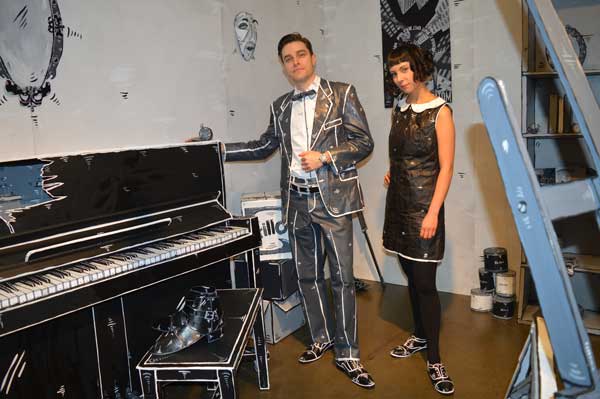
DOSSHAUS’ David Connelly & Kelly Taylor, photo by Lynda Burdick.
Dosshaus was a real showstopper, their booth transformed into an artist’s studio/study. Every object was whimsically constructed out of cardboard painted in monochromes—a standing easel, a manual typewriter on a desk, a bookshelf lined with cans of paint, books, a melting clock (a Dali reference!). The artists themselves, Zoey Taylor and David Connelly, were wearing matching outfits, boasting dress and suit whose surfaces were painted in the same black-and-white tones. The works were being sold quite reasonably, from $30 for small “pins” to four figures for larger works, such as the upright piano and bench. “We work so closely together,” said Connelly in his dapper monochrome suit, “that it’s hard to say exactly what each of us has done on a piece.”
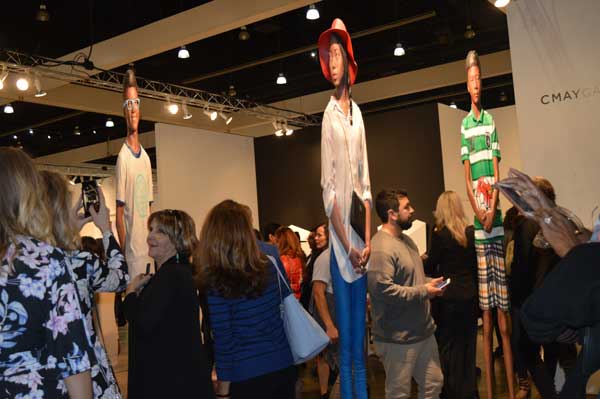
Yi Hwan Kwon’s tall figures presented at CMay Gallery in LA Art Show, photo by Lynda Burdick.
Another highlight were the sculptural figures of Korean artist Yi Hwan Kwon, presented at CMay Gallery and an installation showing various “people” waiting at a bus stop. These hyper-realistic figures are strangely attenuated, though at certain angles they look nearly naturally proportioned.
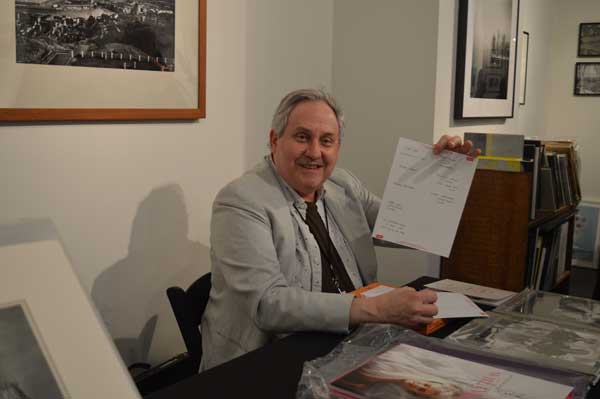
Stephen Cohen, founder of photo la, photo by Lynda Burdick.
Running over the same weekend was photo LA (Jan. 12–15), attracting photo fans to the LA Mart Building in DTLA. As always, the Blind Photographers’ Guild had some of the most intriguing work. Bruce Hall has been organizing this booth for many years running, and this year he was joined by Alice Wingwall, who has produced some beautiful photographs featuring her guide dog in different settings, and Pete Eckert, who shoots long-exposure photographs incorporating models and light sticks in the dark. Eckert “paints” in light during the exposure, sometimes filling in the model’s body with a skeletal form, sometimes adding in musical instruments, creating eerily spectral effects.
At the photo fair I always drop by the Monroe Gallery with its emphasis on photojournalism. It was especially timely that they were showing a series of 1965 photographs from the daily life of Richard and Mildred Loving—done by Grey Villet for a LIFE magazine story. In 1958 the interracial couple were arrested in their home for transgressing the miscegenation law in the state of Virginia, and, sadly, forced to move to Washington, DC. Later they became the center of the case that struck down those laws in the Supreme Court. Recently their story was brought to the big screen in Jeff Nichols’ Loving. (For her quietly powerful portrayal of Mildred Loving, Ruth Negga has been nominated for a Best Actress award at the upcoming Oscars.)
Two other fairs that took place in January were Art Los Angeles Contemporary (Jan. 26–29) at the Barker Hangar in Santa Monica, and stARTup Fair LA (Jan. 27–29) at the Highland Gardens Hotel in Hollywood.

